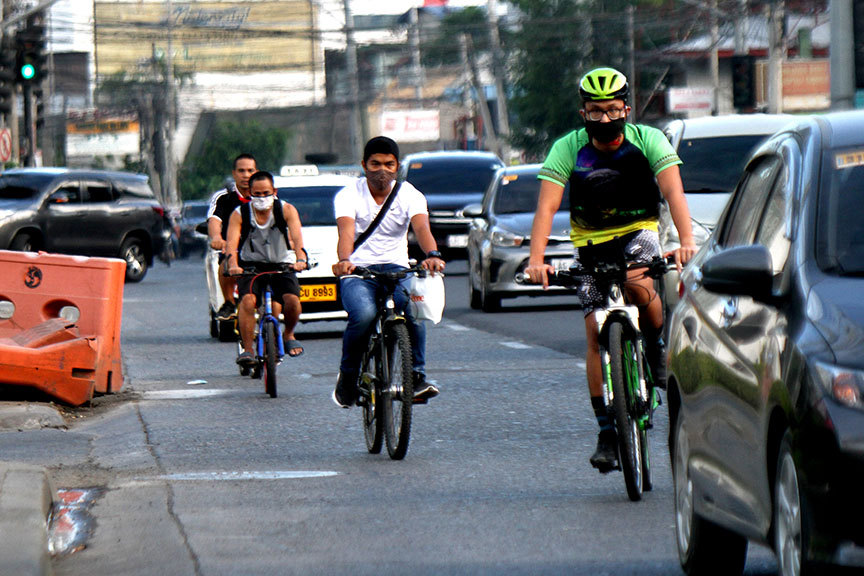DAVAO CITY (MindaNews / 27 May) – The Davao City Transport and Traffic Management Office (CTTMO) is set to identify and inspect more streets for the drafting of a bicycle route plan in preparation for the establishment of bicycle lanes in Davao City as mandated by an ordinance passed a decade ago.
 A usual scene in Davao CIty’s major streets these days (photo taken Tuesday, 26 May 2020) as the number of bikers rise after Davao City was placed under general community quarantine to help curb the spread of COVID-19. Mindanews Photo
A usual scene in Davao CIty’s major streets these days (photo taken Tuesday, 26 May 2020) as the number of bikers rise after Davao City was placed under general community quarantine to help curb the spread of COVID-19. Mindanews Photo
Chinkie P. Golle, executive director of the Interface Development Interventions (IDIS), said this is a major development in the 10-year battle of environmentalists and cycling advocates here to implement Ordinance No. 0409-10 or the Bicycle Ordinance.
In an interview, Golle said Mayor Sara Duterte has already instructed CTTMO head Dionisio Abude to implement the ordinance and will present a route plan, including the “needs and other requirements” for the bicycle lanes.
Authored by late Councilor Leonardo Avila, one of the city’s green champions, the ordinance provides that the CTTMO shall designate the routes to be considered as “signed shared roadways or signed bike routes” and install signs along the routes to “indicate to the bicycle users that particular advantages exist in using the route and more importantly to serve as notice to motorized vehicle drivers that bicycle traffic is present.”
In her interview over Davao City Disaster Radio (DCDR 87.5) on Tuesday, Duterte said she had already discussed with Abude to study the implementation of the bicycle lanes in recognition of the growing clamor of the advocates here for bicycle lanes to ensure the safety of the cyclists since several Dabawenyos are seen riding their bikes on the roads during the coronavirus disease (COVID-19) pandemic.
“I discussed it earlier with CTTMO to study the bike lanes for its implementation,” she said.
Golle said she welcomed this long-overdue development and hoped it would finally take off the ground since there is an immediate need to secure the safety of the growing number of cyclists on the road.
“Biking is a better and healthier option for the environment and public health but we are also concerned about [the riders’] safety. So, the bike lanes and/or routes will help protect them from accidents,” she said.
Golle asked the CTTMO to prioritize the bicycle lanes.
“We also urge the CTTMO to prioritize this. Let the people bike to work but you have to install bike lanes and routes for their safe travel. No more excuses please,” she said.
In his interview broadcast live over DCDR 87.5 last May 19, Abude said the bicycle lanes might not be feasible as the roads in the city are narrow and the outer lanes, the space eyed for bicycle lanes, are already intended for the loading and unloading of passengers.
“We always compare Davao to other areas. If we look at Davao, our roads are really narrow and problematic. If we create bike lanes, they should be in the outer lane. However, we cannot allocate one lane just for them because we only have two or four lanes,” he said at that time.
He said the CTTMO has not identified bicycle lanes due to the current limitations of the roads. But he added the cyclists are encouraged to ride their bikes but reminded them to be extra careful knowing fully well the perils they could encounter on the road.
Abude’s remarks did not sit well with cycling advocates.
Manila Bulletin photojournalist Keith Bacongco, a bike enthusiast himself, said Abude’s previous claims that the narrow streets of Davao have made it impossible to accommodate the bicycle lanes have no basis, hoping he would open up his mind and not immediately shoot down the request of the cyclists who desire for safer roads.
Bacongco dared Abude to ride a bicycle on his own around the city for a week to know the plight of many workers who are biking to work these days.
He said the cyclists did not demand an entire lane to be designated as a bicycle lane, believing that there is a standard dimension for bicycle lanes for various street measurements.
“I don’t know if he has seen the influx of bikers on the road. One more thing, the bikers don’t ride their bikes to work the entire day, you will see many of them from 6 to 8 a.m. Around 9 a.m., you will only see a few of them. In the afternoon, you will see them out on the roads again starting 4 until 6 o’clock,” he added.
Bacongco said he was baffled as to how the CTTMO could tolerate the car owners who have been parking their vehicles along the outer lanes but not so with cyclists who are just passing.
“I’m speaking not just as a journalist but also as a citizen of the city. I’ve been biking for a long time. I bike to work whenever time, weather, and my body permit. It’s a matter of choice. These days, many have shifted to biking because of the scarcity of public transportation like PUVs and as part of the social distancing measures,” he said.
Sustainable Davao Movement (SDM) co-convener Mylai Santos welcomed this development and encouraged the CTTMO head to make a swift move to get the ordinance implemented.
She also asked the locals to help clear the sidewalks and roads by not using the outer lanes for parking and patronizing the street vendors only in their designated areas such as the Roxas Night Market once everything gets back to normal.
“We should reclaim the sidewalks for pedestrians, and the roads for all road users and not for vehicle parking and other activities,” she said.
Environment planner Lemuel Manalo, who is IDIS research specialist, said Mayor Duterte’s pronouncement was good news for the members of the Davao’s cycling community, including those who are planning to start using their bikes for commute.
“We urge the Mayor and the local government for a participatory planning process over this like holding consultations with cycling groups, urban planners and designers, environmental advocates, etc. They are very active online and on social media to help assess and recommend” he said.
He suggested that the assessment and study of the lanes would be more helpful if a survey is done using the bicycles to address the actual problems on the ground. (Antonio L. Colina IV / MindaNews)
